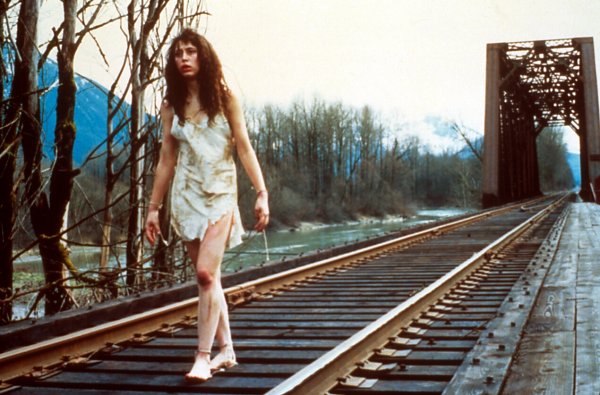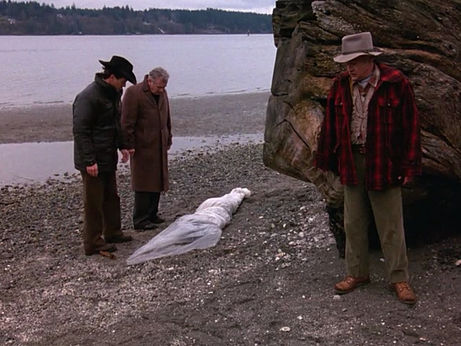
Image still from Twin Peaks episode two.
Inspired by Casey's Halloween post on gender in the horror genre, I'm continuing to riff on the same theme; I'll talk about boredom and violence, truck stop killers, and, of course, Laura Palmer.
So I just finished watching Twin Peaks. I'm behind the times in tackling this one, but now the show is up there on my list of favorites. That said, while watching over the past few months, I couldn’t help but notice that the underlying message seems to be: Young Women who display independence and/or sexual curiosity will probably be murdered by a deep woods demon. Laura Palmer is only the first casualty. By the series’ end—no serious spoilers here—we have to wonder what will become of our various other heroines. Audrey Horne, Donna Hayward, Shelly Johnson. And of course there remains the question of questions: How’s Annie?
Twin Peaks is a slow, small town with a toxic heart; like most small towns, you might say. In depicting this fictional Washington community, the show flips back and forth between scenes of boredom and scenes of violence. Sometimes everyone is sitting around talking about how great the pie is, or they’re eating donuts from perfectly organized stacks. And then sometimes they’re beating one another with bars of soap, trying to garrote one another in bed, or shooting each other point plank. And isn’t this the way with any good horror scenario or urban legend? Things have to start out a bit too quiet, and that’s when terror comes to roost.
Plenty has been written about Twin Peaks, specifically about the use of the mutilated female body in the show. Why is Laura Palmer’s plastic-wrapped body in the pilot episode so chilling and so beguiling? (Remember that Lynch found a local girl to play Laura, claiming he hired her "just to play a dead girl"; "But no one—not Mark, me, anyone—had any idea that she could act, or that she was going to be so powerful just being dead.") The fact that this wholesome-seeming, community fixture from a wealthy family, who happened to be played by a beautiful young woman, presents a haunting image once murdered and thrown in the lake? Not all that surprising.

Image still from Twin Peaks pilot episode.
But I’m thinking now of other kinds of violence toward women that tend to go unseen, unnoticed, or unremembered. Vanessa Veselka’s "The Highway of Lost Girls," published in GQ and collected in the 2013 Best American Essays, describes hitchhiking as a teenaged female runaway in the 1980s, taking rides from commercial drivers from truck stop to truck stop. Veselka has a run-in with a truck driver she will suspect, years later, is famous serial killer Robert Ben Rhoades, whose “trucking logs place him in the area of fifty unsolved murders in the three years prior to his arrest alone.” Veselka argues that Rhoades was able to get away with these murders—“at his peak he was killing one to three women a month”—because the victims he chose weren’t a part of any group that the community valued. As Veselka continues to search for evidence of other women Rhoades likely killed, everyone she asks, from local law enforcement to truck stop owners, denies ever having heard of the dead women. Despite the fact that the body was found in their dumpster, for example.
Veselka writes, “our profound fascination with serial killers is matched by an equally profound lack of interest in their victims.” This is the case when the victims are drifters, women who don’t belong to any clear family or community, or women who have removed themselves from such communities, especially through engagement in the sex industry. Or, as the FBI's Highway Serial Killings Initiative describes them, "The victims in these cases are primarily women who are living high-risk, transient lifestyles, often involving substance abuse and prostitution." While the fictional Laura Palmer’s death brings in a full-on FBI investigation (conducted by an all-male team of investigators and local law enforcement officers), hundreds of real women meet the same fate along the interstate daily and, as Veselka’s piece illustrates, can never even be properly identified (The Highway Serial Killings Initiative, started in 2009, took an initial count of over five hundred bodies around truck stops and rest areas alone.)
To bring this back to the context of fictional Twin Peaks, here's the question on my mind: does anybody really care about Ronette Pulaski?


Recent comments
2 years 29 weeks ago
2 years 44 weeks ago
2 years 44 weeks ago
2 years 50 weeks ago
3 years 4 weeks ago
3 years 4 weeks ago
3 years 4 weeks ago
3 years 6 weeks ago
3 years 6 weeks ago
3 years 6 weeks ago